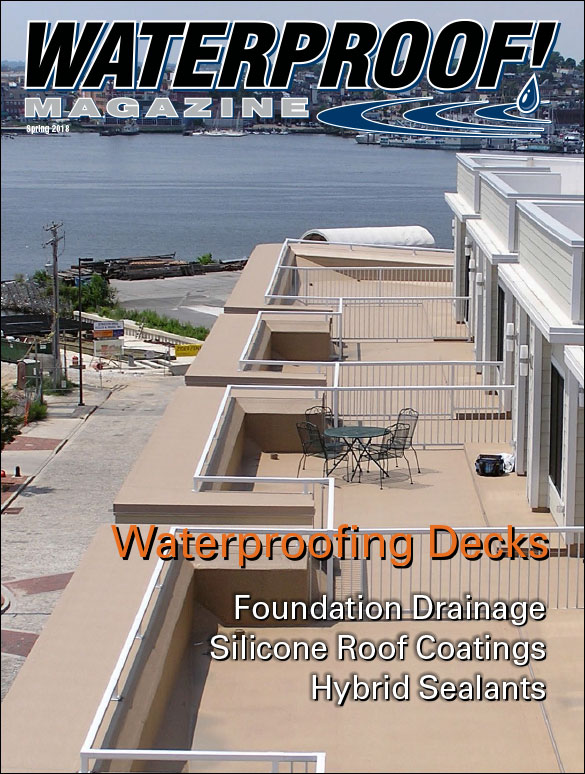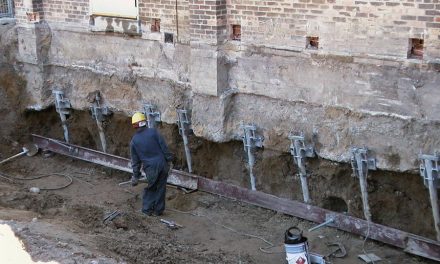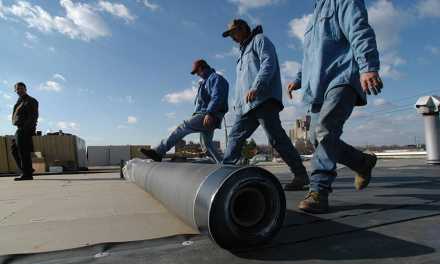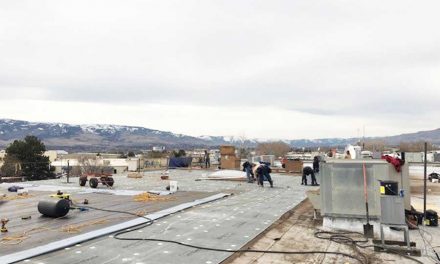Silicone roof coatings are flexible, easy-to apply and extremely durable. They can rehabilitate a wide variety of roof types, such as this EPDM roof in Sharonville, Ohio .
Every building owner will eventually have to replace their roof. In the past, the standard procedure was to completely tear off and replace it. In the past two decades, roof coatings have made it possible to extend the roof life by recovering or repairing it. Either way, updating a roof covering is a common but major maintenance expense. According to the Roof Coating Manufacturers Association (RCMA), over three billion sq. ft. of roofing is replaced or recoated each year, and roofing materials are the third greatest contributor to waste in landfills.
Roof coatings are an ideal solution to extend the life of an existing roof while preventing tear-off and waste. Coatings can be used over a wide variety of existing roof coverings, including built-up roofing (BUR), metal, modified bitumen, single-ply, and spray polyurethane foam.
Manufacturers offer a number of different roof coating chemistries. The most common formulations are acrylic, polyurethane, and silicone.
Advantages
Silicone-based coatings can resist standing water better than acrylics, and are easier to apply than two-component polyurethanes. In short, silicone roof coatings combine ease of application with durability, water resistance, and minimal UV degradation.
Scott Lelling, senior manager, strategic marketing of Polyglass, says, “These advanced silicone coatings offer tremendous weatherproofing advantages that make sense for the contractor, the building owner and the environment.”
Silicone roof coatings are generally white (for energy savings), but other standard and custom colors are available.
Another major advantage of silicone is its flexibility. Tim McQuillen, technical director at RMCA explains, “Silicone coatings can move with expansion and contraction over a wide range of temperatures. They can resist extreme temperature changes over a long period of time and do not become brittle.”
![]()
He continues, “Silicone coatings can reduce energy costs. A highly reflective coating can keep the roof surface cooler by reflecting radiation from the sun. This also allows rooftop A/C units to operate more efficiently.”
Unlike paints, silicones are permanent. The will not wash off over time, so they maintain their reflectivity values. They do not fade, chalk, degrade or crack when exposed to the sun’s ultraviolet rays. They are also resistant to staining, mold and mildew.
Silicones are considered an environmentally friendly coating. First, because they extend roof life and prevent material from going to the landfill. But also, they have a high percentage of solids. That means virtually no volatile organic compounds (VOCs) and any waste generated is non-hazardous.
Installation
The 2018 Building Code allows for recoating over existing roofing systems as well as recoating over an existing coating. The installation of a silicone roofing system will vary depending on the substrates and the roof coating manufacturer, and building owners and managers are encouraged to ensure that the roofing contractor applying the coating is authorized by the manufacturer and follows the manufacturer’s written installation instructions.
In most cases, no primer is required. Silicone coatings have been successfully applied directly over BUR, modified bitumen, single-ply, and spray polyurethane foam. Surfaces which generally require primer include concrete roof decks; metal flashings, gravel stops, and other metal edging; masonry walls and floors; gypsum, and other porous surfaces.
Some coatings, like GE Sealants’ Enduris line, recommend using a bleed blocking base-coat over asphaltic roofing only to prevent possible bleed-through of asphaltic oils which could discolor the surface but do not otherwise interfere with performance.
Silicone coatings can also extend the life of metal roofs while decreasing energy use. Usually no primer is required.
Rusted metal roofs can be coated after the rust conditions have been addressed. If the roof is “white rust” (zinc or aluminum), it can be coated after cleaning. If the roof is “red rust,” the rust must be removed or treated with a corrosion inhibiting primer. All rusted fasteners should be treated or replaced.
Bob Creighton, senior marketing manager at GE Sealants, say, “Basically you get the roof into a structurally stable condition, clean it via pressure washing or air compressor and then roll/spray.”
As with any roof coating, proper preparation is key prior to the application. Every manufacturer has specific requirements for their product lines. In general though, a roof must be thoroughly cleaned and allowed to dry to ensure a successful coating application. Usually, this is done with a pressure washer. However, the contractor should take extra care to protect the underlying roof membrane, especially any adhered membrane seams.
McQuillen warns, “A primer is no substitute for thorough cleaning. Dust, chalking film, bitumen exudate, greases or oils, and other loose debris should be cleaned off the roof prior to the application of coatings.”
Any required roof or flashing repairs should be completed and allowed to adequately cure.
Once the prep work is done, the coating goes on quickly. Most can be applied via roller, squeegee, or spray gun, depending on the manufacturer’s recommendation.
McQuillen says, “Silicones have the capacity for high build and typically you only need a single coat to obtain excellent performance. However, silicones adhere to themselves thus making it easy for a re-coat application if necessary.”
He continues, “A silicone roof coating is an optimal choice when the building owner cannot have disruptions in their normal day operations. The avoidance of dumpsters and noise associated with the removal of an existing roofing system is not an issue with the application of a roof coating. In cases where standing water may be an issue on the existing roofing system, a silicone coating would be the preferred coating of choice. The cost to apply a roof coating versus tearing off the roofing system is substantial both in materials and labor costs.”
Case Study
One notable case study is the federal Defense Logistics Agency (DLA) in Scotia, New York. The cold, snowy winters and hot, wet summers put immense stress on local buildings’ roofs, which is why they chose a silicone roof coating as a first coating in 1996. At the time, GE Enduris Performance Coatings was one of the few silicone products on the market, and was the product of choice. When crew checked last summer, more than two decades of punishing weather had removed about five mils of the original 21.5 mils coating surface, but most of the surface was in fine condition.
Less than 5% of the silicone roof coating on the DLA building needed replacing, despite more than 20 years of punishing weather.
“We had a terrific first experience with the product,” says Dave Landry, DLA director of operations. “Twenty years later, there was no question about who we’d use.”
In the end, only 5% of the 275,000-sq.-ft. roof required repair; the rest just needed a few more mils of coating. DLA chose to cover the previous gray coating with the white version this time, helping to lower the amount of heat absorbed by the roof.
“Most building owners in this area spend thousands, sometimes hundreds of thousands, each year keeping their roofs intact,” says Landry. “We spend almost nothing in comparison.”
It also cut down on expenses for the installation crew. Bill Rush, who led the team that applied the coating, says, “During the seven-week project, we lost only one day to rain. If it had been an acrylic coating, we would have likely lost a week to predicted rain delay.”
Outlook
Silicone roof coatings are growing rapidly in popularity. The Freedonia Group, a Cleveland-based industry research firm, expects demand to rise 5.1% annually through at least 2021.
Creighton, at GE Sealants, says his silicone roof products have seen far greater growth rates in the past several years. He expects that silicone roof coatings will become even more popular as the market becomes more familiar with them. “I suspect that silicone roof coatings have gotten a bad reputation from acrylics,” he says. “Acrylics don’t pass the 24-hour ASTM ponding water test, and almost every low slope roof has—or will within the 20-year warranty period—at least a small area that has a pond. A building owner doesn’t care that 99% of his roof doesn’t leak if 1% does. So with silicone solving that problem, it’s just a question, in my opinion, of knowing the option is there.”
![]()
Price is another driver. While the RCMA declined to discuss pricing due to anti-trust concerns, Creighton estimates that a silicone restoration coating is generally half the installed cost of a tear off. Additionally, tax code allows the coating to be depreciated in a single year because it’s a maintenance item, rather than being considered a re-roof.
The Freedonia study cited earlier anticipates silicone roofs can be a significant profit center for roofing companies. “Silicone coatings can be completely installed in a few days using only moderately skilled crews,” the study states. “A shortage of trained roofing installers points to steady demand for the next few years.”
Due to their ease of application, it’s fairly easy for a roofing contractor to add silicone roof coatings to their list of services.
“While a silicone coating restoration is an excellent value for many roofs, we see a particular set of conditions where silicones should always be the right solution for the building owner,” Creighton says. Building codes do not allow a third roof, and since many of these second roofs are single-ply—about 60% of roofing membrane sales—when these reach the end of their life expectancy, a roof coating is the only practical alternative to a tear-off.
Spring 2018 Back Issue
$4.95
Hybrid Sealants for Crack Repair
AVAILABLE AS DIGITAL DOWNLOAD ONLY
Description
Description
Additional Info
Additional information
| Magazine Format | Digital Download Magazine, Print Mailed Magazine |
|---|




















hi i have a roof company i need a silicone 100%